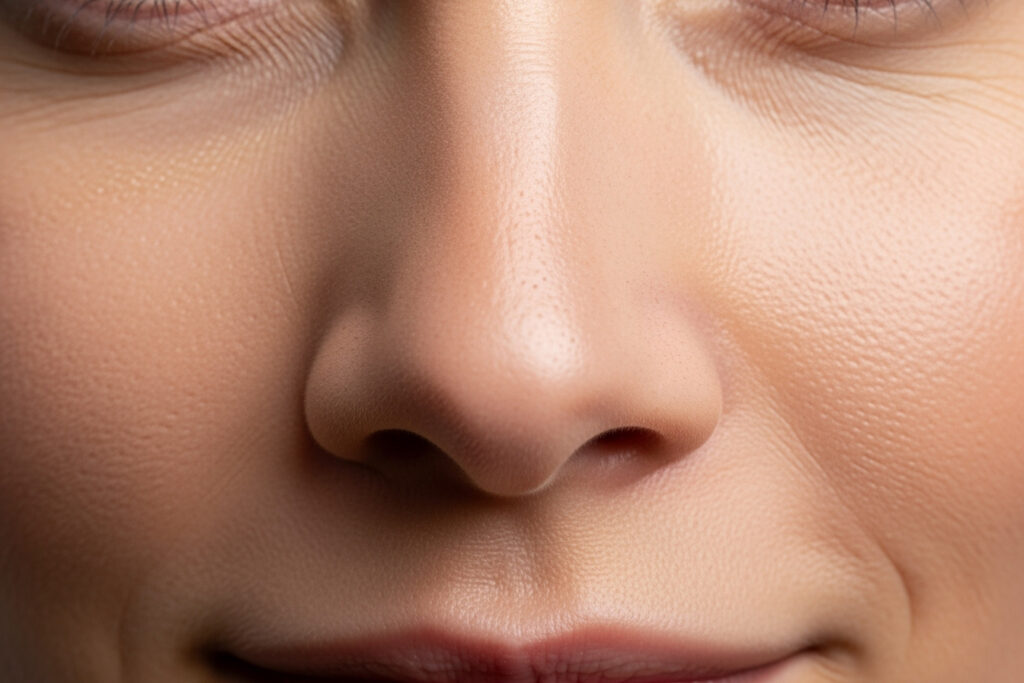Understanding the Challenge: Why Nose Pores Seem So Stubborn
Learning how to minimize pores in nose begins with understanding what they are. These tiny openings are essential parts of your skin’s natural system, not just cosmetic concerns.
Quick Answer: Essential Steps to Minimize Nose Pores
- Cleanse twice daily with a gentle, non-comedogenic cleanser
- Exfoliate 2-3 times weekly using salicylic acid or gentle AHAs
- Moisturize daily with lightweight, oil-free formulas
- Apply SPF 30+ sunscreen every day to prevent collagen damage
- Use targeted treatments like niacinamide or retinol at night
- Avoid picking or squeezing pores to prevent irritation
Pores are openings for hair follicles and sebaceous glands, which produce sebum–a natural oil that moisturizes and protects your skin. The nose has larger, more active sebaceous glands, which is why pores appear more prominent there.
While genetics mostly determines your pore size, factors like sun damage, clogged debris, and loss of skin elasticity can make them look larger. You can’t permanently shrink pores, but you can significantly minimize their appearance with consistent care. This article will show you how to clean, treat, and maintain your nose pores for smoother-looking skin.
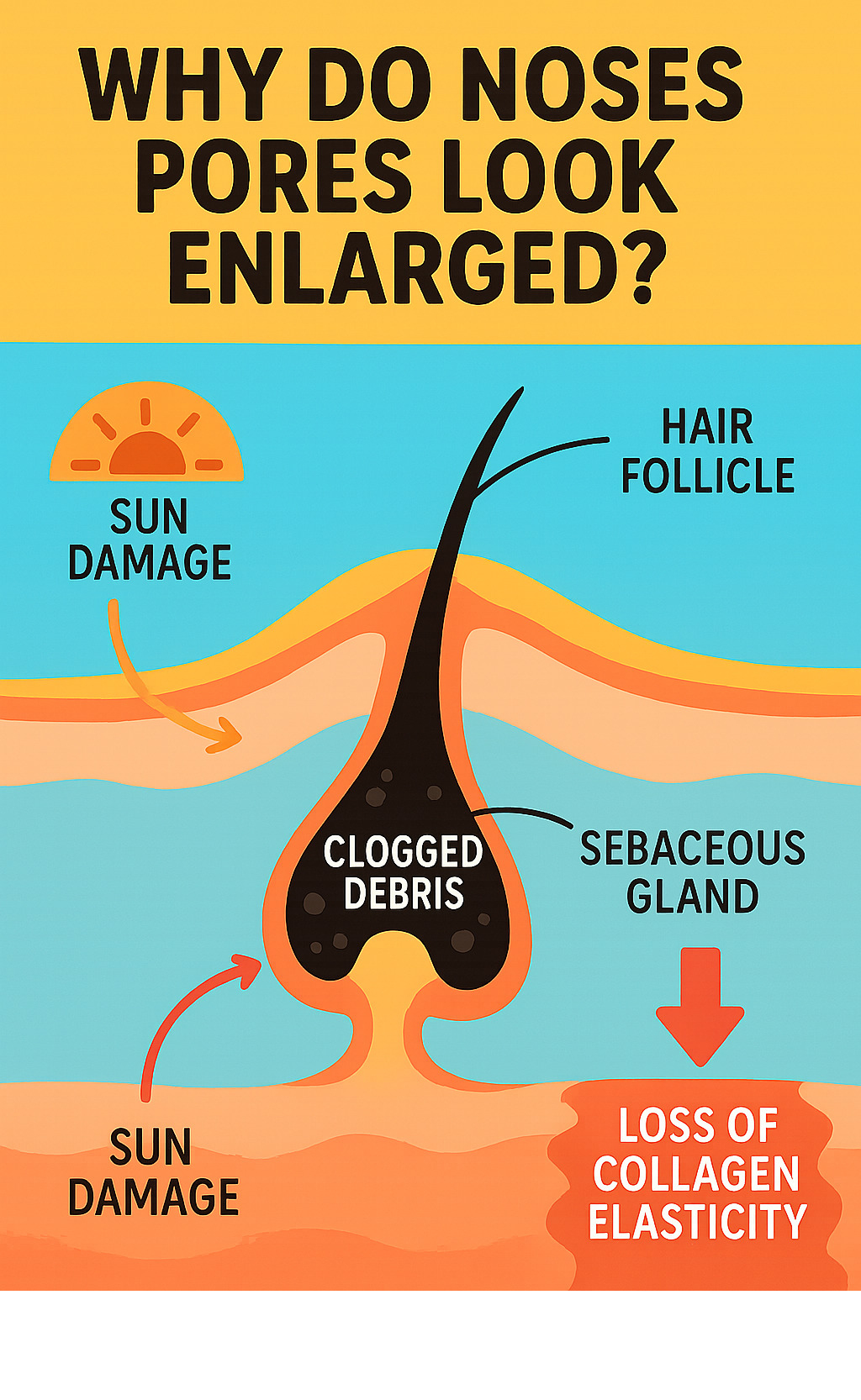
How to minimize pores in nose terms simplified:
Why Do Nose Pores Look So Big?
Your nose is in the center of your T-zone, an area packed with sebaceous glands. These glands produce oil to keep your skin moisturized, and they are naturally larger and more active on the nose than elsewhere on your face.
Understanding how to minimize pores in nose means recognizing they aren’t broken; they’re just more active. Pores are essential doorways for sebum release, and your nose simply has more of them. For a deeper understanding, check out our educational resource on nose pores.
Natural and Genetic Factors
Genetics is the biggest factor in determining your natural pore size. If your parents had visible pores, you likely inherited that trait. As we age, our skin also loses collagen and elastin, the proteins that keep skin firm. As this internal support system weakens, pores can appear wider because they lack the structure that once kept them tight. You can learn more about this process in this resource on elastin.
Hormones also play a starring role. During puberty, hormonal shifts increase oil production, which can lead to clogged, expanded pores. Women may notice more prominent pores during their menstrual cycle, and men typically have more active sebaceous glands, contributing to more visible pores throughout life.
How Lifestyle and Habits Affect Pore Size
Your daily choices significantly impact how noticeable your nose pores appear. Sun damage is one of the biggest pore enemies.
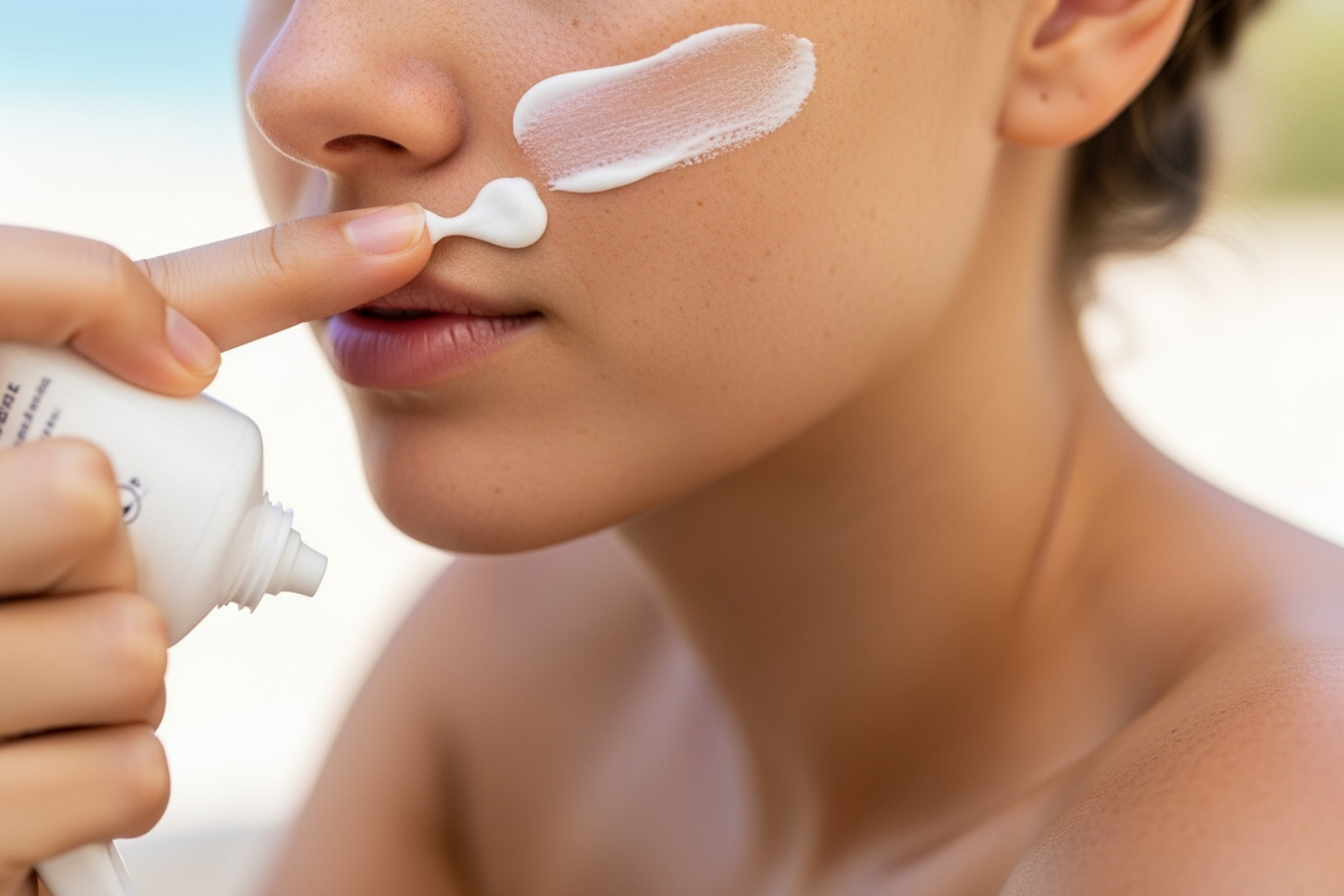
UV rays break down collagen and elastin, making skin less firm and pores more prominent. Clogged pores are another major culprit; when oil, dead skin cells, and dirt get trapped, they stretch the pore opening.
Improper cleansing can leave debris behind, while aggressive scrubbing can cause irritation that makes pores look worse. Picking and squeezing your pores also makes everything worse, as it can cause inflammation, push bacteria deeper, and permanently stretch the pore. Even factors like diet and stress can influence oil production. For comprehensive guidance on managing oily skin, explore our guide to oily face pores.
Your At-Home Action Plan for How to Minimize Pores in Nose
You don’t need expensive treatments to see real improvements. How to minimize pores in nose is achievable with a consistent, gentle routine at home. The goal isn’t to eliminate pores, which are essential, but to keep them clean and supported so they appear smaller.
The secret is gentle consistency. Irritated pores look more prominent, so regular, non-inflammatory care is key. For a personalized approach, check out our skincare routine for oily skin with large pores.
The Foundation: Cleansing and Exfoliating
Proper cleansing is the most fundamental step. Twice-daily cleansing removes overnight oil and the day’s accumulation of dirt and pollutants that can settle in pores.
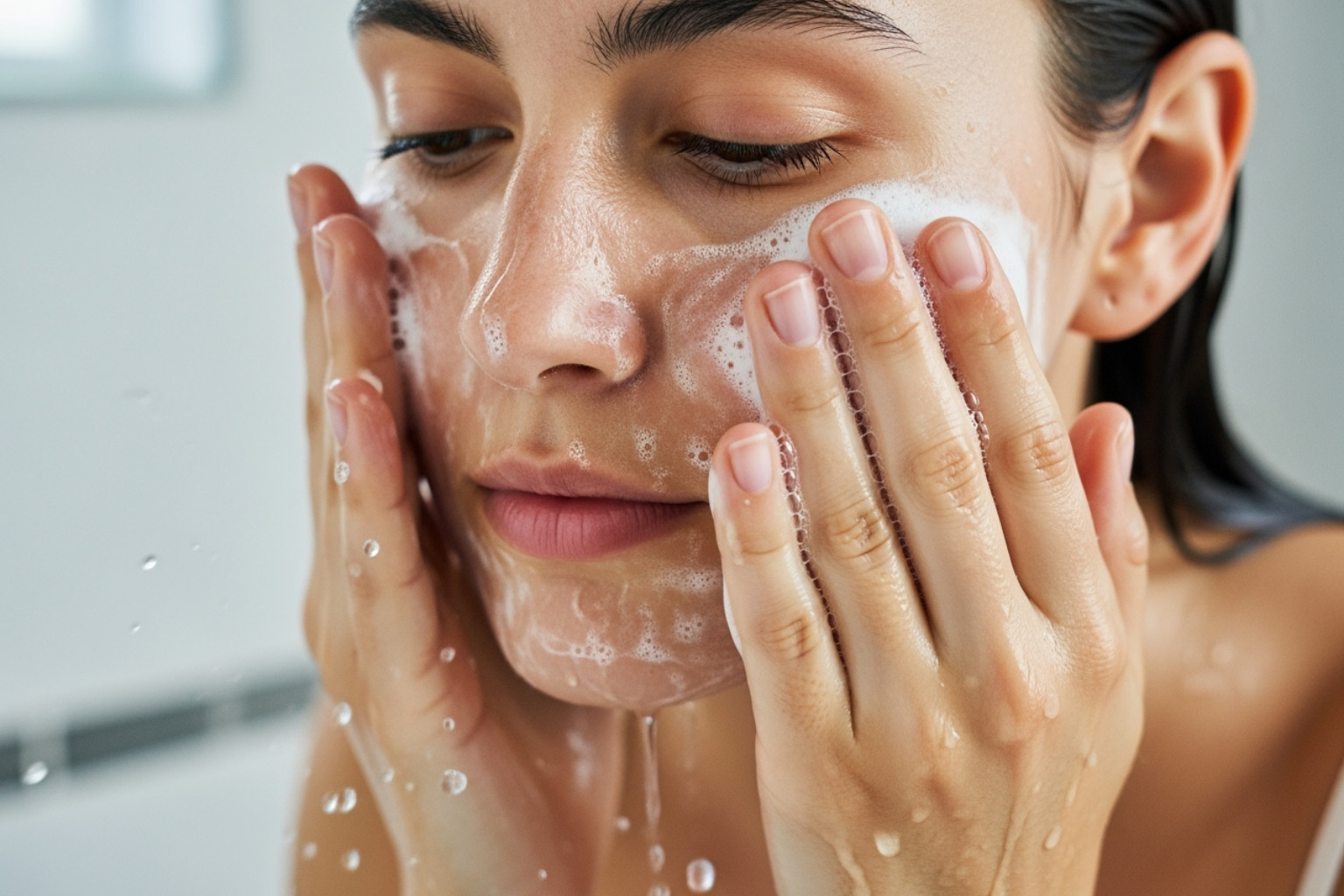
Choose a gentle, non-comedogenic cleanser that won’t strip your skin’s protective barrier. Use lukewarm water and gently massage the cleanser onto your face, paying special attention to the nose. Rinse thoroughly and pat dry.
Regular exfoliation is your next step. It removes dead skin cells that can mix with oil and clog pores. Physical exfoliants use fine grains to manually remove cells, but must be used gently to avoid irritation. Chemical exfoliants use acids to dissolve the bonds between dead cells. Salicylic acid is excellent for nose pores as it’s oil-soluble and can clean deep inside, while glycolic acid promotes healthy cell turnover on the surface.
Start by exfoliating 2-3 times per week. Gentle, regular exfoliation is far more effective than aggressive scrubbing. For more guidance, explore our resources on non-comedogenic products.
The Support System: Moisturizing and Sun Protection
Skipping moisturizer is a common mistake. When skin lacks hydration, it can overcompensate by producing more oil, making pores look larger. The key is choosing the right product. Lightweight, oil-free formulas provide necessary hydration without feeling heavy or clogging pores. Well-hydrated skin is more resilient and helps pores appear smaller.
Sun protection is essential for long-term results. UV rays break down the collagen and elastin that keep skin firm. As these proteins deteriorate, pores look larger. Using a broad-spectrum sunscreen with SPF 30 or higher every day protects your skin. Research in Dermatologic Surgery found daily sunscreen use significantly improves skin texture. For convenience, consider a lightweight moisturizer for oily acne-prone skin that includes SPF.
Key Ingredients and Advanced Solutions
With a solid foundation of cleansing, moisturizing, and sun protection, you can level up your how to minimize pores in nose strategy with targeted treatments. If at-home efforts aren’t enough, find a skincare expert at Beyond Beauty Lab for a custom plan.
Powerhouse Ingredients for Your Pores
These science-backed ingredients tackle pore concerns from different angles.
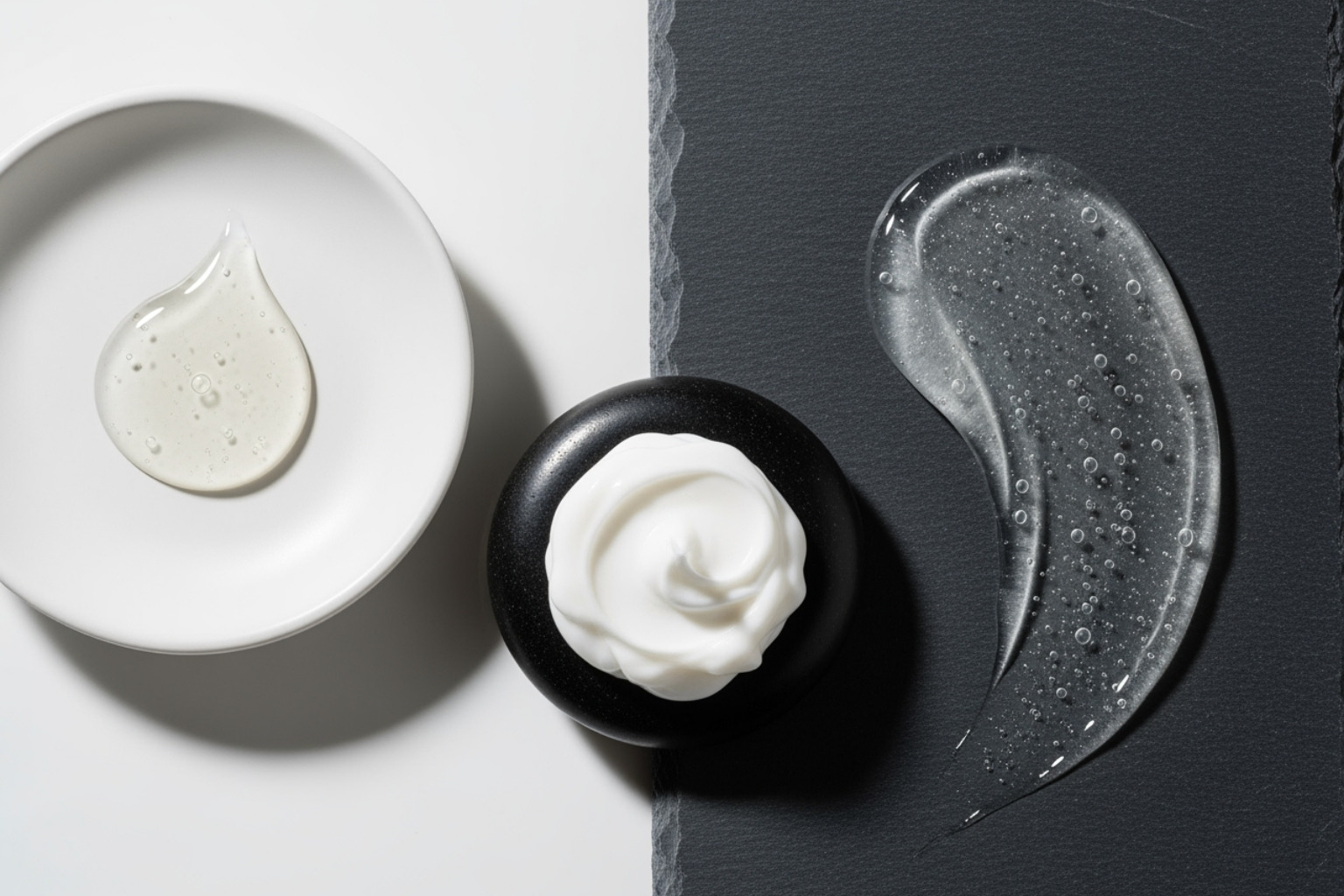
- Salicylic Acid (BHA): Being oil-soluble, it dives deep into pores to dissolve clogs, making it ideal for oily and acne-prone skin.
- Glycolic Acid (AHA): This works on the surface, sweeping away dead skin cells to promote smoothness and less noticeable pores.
- Niacinamide: A form of Vitamin B3, this multitasker helps balance oil production, improve skin elasticity, and strengthen the skin’s barrier.
- Clay masks: Bentonite and kaolin clays act like magnets for oil and impurities, temporarily tightening skin and making pores look smaller.
The connection between gut health and glowing skin also plays a role in your skin’s overall appearance.
The Role of Retinol in How to Minimize Pores in Nose
Retinol, a Vitamin A derivative, is a top-tier ingredient for pore care. It works by boosting cell turnover, which helps unclog pores and prevent new blockages from forming. More importantly, retinol supports collagen production, which helps keep the skin firm around pores so they appear smaller. Research in the Journal of Cosmetic Dermatology confirms retinol helps prevent skin aging.
When starting with retinol, begin with a low concentration 2-3 times per week at night, increasing frequency as your skin builds tolerance. Always pair retinol with daily sunscreen, as it increases sun sensitivity.
When to Consider Advanced Skincare Solutions
When topical products aren’t enough, professional treatments can provide an extra boost.
- Chemical peels offer deep exfoliation to improve pore appearance over multiple sessions.
- Microdermabrasion gently buffs away the outermost skin layer for a smoother texture.
- Laser therapy can stimulate collagen, tighten skin, and reduce pore appearance.
- Microneedling uses tiny needles to stimulate collagen and elastin production, naturally firming the skin.
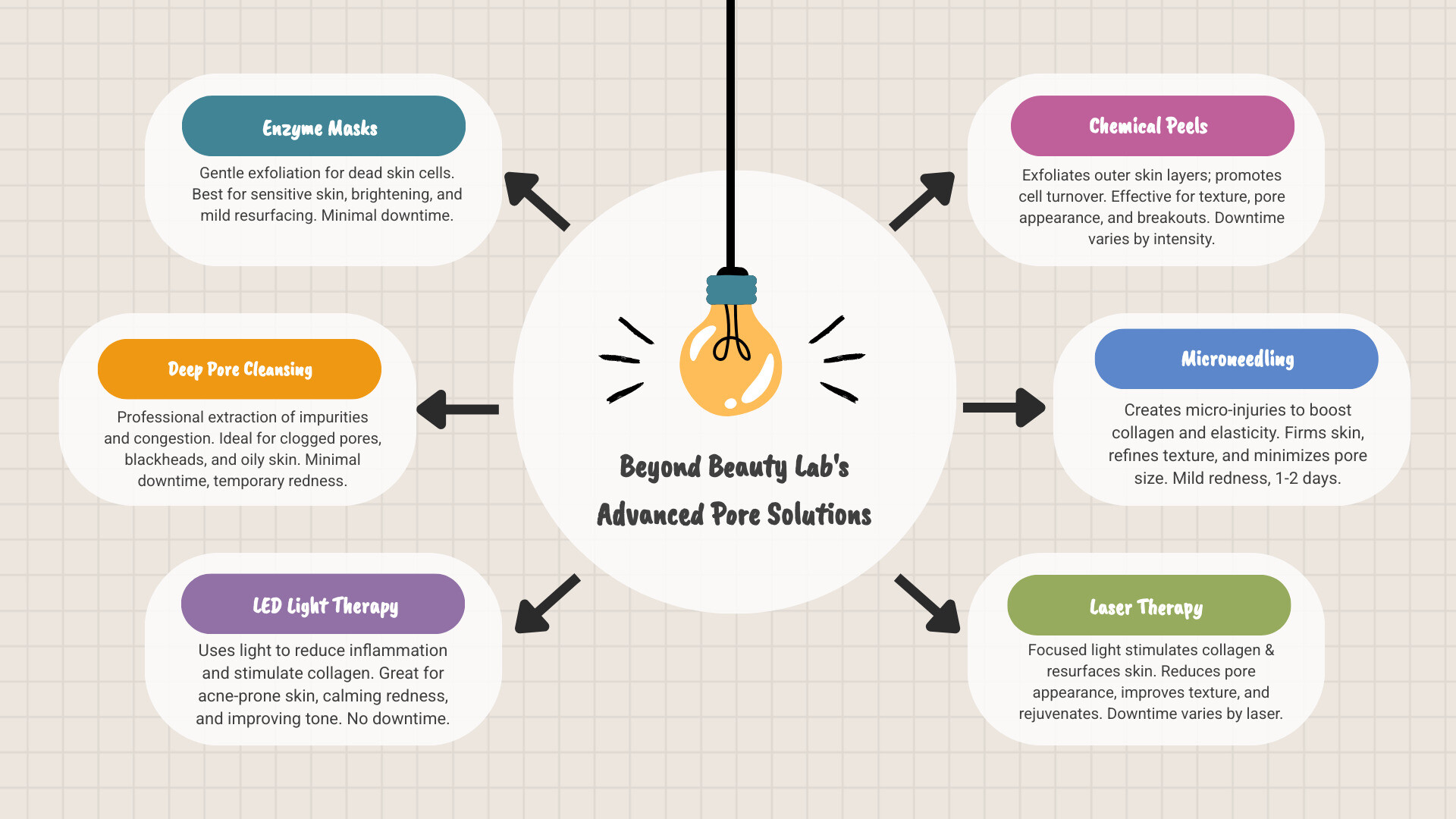
Consult a skincare expert to determine which treatment is right for you. At Beyond Beauty Lab, our advanced facial treatments target specific concerns like pore refinement. We invite you to explore Beyond Beauty Lab’s advanced facial treatments to find your solution.
The Ultimate Do’s and Don’ts for Nose Pore Care
Navigating how to minimize pores in nose comes down to building healthy habits. These expert-backed guidelines simplify what works.
The Do’s:
- Cleanse Daily: Wash twice a day with a gentle, non-comedogenic cleanser to remove oil and dirt.
- Exfoliate Gently: Use chemical exfoliants (salicylic acid, AHAs) 2-3 times a week to prevent buildup. If using physical scrubs, be extremely gentle.
- Moisturize: Even oily skin needs hydration. Choose lightweight, oil-free formulas to prevent your skin from overproducing oil.
- Use Sunscreen Daily: A broad-spectrum SPF 30+ is non-negotiable for protecting the collagen that keeps pores looking tight.
- Be Patient and Consistent: Use targeted ingredients like niacinamide and retinol, and remember that results take time.
The Don’ts:
- Don’t Squeeze or Pick: This causes irritation, inflammation, and potential scarring, making pores look worse.
- Don’t Use Harsh Scrubs: Aggressive tools and scrubs can damage your skin’s barrier and increase irritation.
- Don’t Skip Moisturizer: This can backfire by triggering more oil production.
- Don’t Over-Exfoliate: More is not better. Overdoing it leads to redness, sensitivity, and increased oiliness.
- Don’t Use Comedogenic Products: Check labels on all skincare and makeup to ensure they won’t clog your pores.
Following these guidelines creates a foundation for healthier skin. For more advice, explore our beauty tips for clear skin.
Frequently Asked Questions about Minimizing Nose Pores
Let’s tackle the most common questions and separate fact from fiction when it comes to how to minimize pores in nose.
Can you permanently shrink nose pores?
No, you cannot permanently shrink your nose pores. Your pore size is determined by genetics and is a permanent part of your skin’s structure. However, you can make them appear significantly smaller. The secret is keeping pores clean and unclogged while supporting your skin’s natural elasticity. When pores are clean and the surrounding skin is firm with collagen, they look smaller and more refined. The key is consistent care, not a magical shrinking solution.
Are nose strips a good way to clean pores?
Nose strips offer temporary removal of surface debris, but we recommend caution. They can be harsh, stripping away beneficial oils and irritating the skin. This irritation can make pores look even more noticeable. Gentle chemical exfoliation with ingredients like salicylic acid is a much better long-term strategy. It dissolves clogs from within the pore without damaging the skin, providing more sustained improvement.
What is the difference between a blackhead and a sebaceous filament?
It’s easy to confuse these two. Sebaceous filaments are normal parts of your skin’s function. They are tiny, whitish-yellow tubes of sebum that line your pores to help oil travel to the surface. They are not meant to be eliminated. Blackheads, on the other hand, are clogged pores filled with a mix of oxidized sebum and dead skin cells, which turns dark when exposed to air. Blackheads are a form of acne that benefits from treatment.
The good news is that both respond well to gentle, consistent care with ingredients like salicylic acid. For comprehensive strategies, check out our guide to the best skincare routine for blackheads and oily skin. The goal is not to eliminate everything, but to keep pores functioning well.
Conclusion: Maintaining Your Results for Clearer Skin
Learning how to minimize pores in nose is an ongoing journey, and consistency is your secret weapon. Visible improvements come from daily dedication, not an overnight fix.
Pore care is a long-term relationship with your skin. With gentle daily cleansing, regular exfoliation, lightweight moisturizing, and diligent sun protection, you give your skin what it needs to look its best. The strategies we’ve covered work as a team to protect collagen, prevent buildup, and support overall skin health.
The goal is healthy skin, not perfection. Pores are essential, and our aim is to help them function optimally so they become less noticeable and you feel more confident.
At Beyond Beauty Lab, we’re passionate about empowering you with knowledge. Understanding why a routine works is key to seeing real, lasting results. Ready to take the next step? Explore our full range of skincare solutions and educational resources to continue building the healthy, confident skin you deserve.

